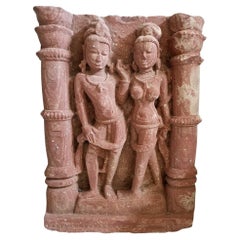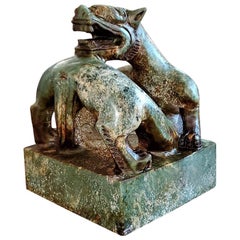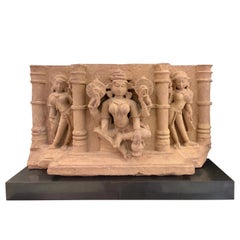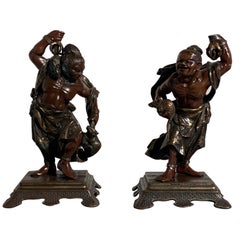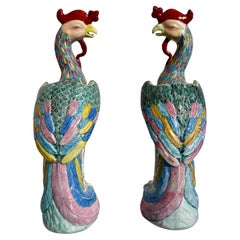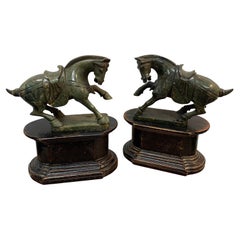Texas - Sculptures and Carvings
15th Century and Earlier Indian Archaistic Antique Texas - Sculptures and Carvings
Sandstone
Mid-20th Century Chinese Meiji Texas - Sculptures and Carvings
Serpentine, Jade
15th Century and Earlier Indian Medieval Antique Texas - Sculptures and Carvings
Sandstone
Late 19th Century Japanese Meiji Antique Texas - Sculptures and Carvings
Bronze
Mid-20th Century Chinese Chinese Export Texas - Sculptures and Carvings
Porcelain
20th Century Chinese Chinese Export Texas - Sculptures and Carvings
Precious Stone, Lacquer
Mid-19th Century Sri Lankan Antique Texas - Sculptures and Carvings
Bronze
Early 20th Century Chinese Chinese Export Texas - Sculptures and Carvings
Soapstone
1920s Japanese Taisho Vintage Texas - Sculptures and Carvings
Bronze
15th Century and Earlier Cambodian Antique Texas - Sculptures and Carvings
Bronze
15th Century and Earlier Chinese Han Antique Texas - Sculptures and Carvings
Terracotta
16th Century Thai Antique Texas - Sculptures and Carvings
Sandstone
19th Century Chinese Chinese Export Antique Texas - Sculptures and Carvings
Wood, Paint
Early 18th Century Chinese Qing Antique Texas - Sculptures and Carvings
Wood
Early 20th Century Chinese Han Texas - Sculptures and Carvings
Jade
19th Century Indian Folk Art Antique Texas - Sculptures and Carvings
Gesso, Wood, Paint
Early 20th Century Burmese Texas - Sculptures and Carvings
Shell, Lacquer
Early 19th Century Korean Antique Texas - Sculptures and Carvings
Wood
15th Century and Earlier Thai Antique Texas - Sculptures and Carvings
Bronze
Early 1900s Thai Antique Texas - Sculptures and Carvings
Bronze
Early 20th Century Chinese Chinese Export Texas - Sculptures and Carvings
Soapstone
Late 19th Century Japanese Meiji Antique Texas - Sculptures and Carvings
Bronze
17th Century Chinese Ming Antique Texas - Sculptures and Carvings
Pottery
Late 18th Century Chinese Qing Antique Texas - Sculptures and Carvings
Boxwood
Mid-20th Century Chinese Qing Texas - Sculptures and Carvings
Porcelain
Late 19th Century Japanese Meiji Antique Texas - Sculptures and Carvings
Bronze
Early 20th Century Thai Texas - Sculptures and Carvings
Teak
17th Century Burmese Antique Texas - Sculptures and Carvings
Bronze
Late 19th Century Chinese Qing Antique Texas - Sculptures and Carvings
Bronze
Early 20th Century Chinese Chinese Export Texas - Sculptures and Carvings
Soapstone
15th Century and Earlier Indian Archaistic Antique Texas - Sculptures and Carvings
Sandstone
15th Century and Earlier Javanese Antique Texas - Sculptures and Carvings
Silver
19th Century Chinese Qing Antique Texas - Sculptures and Carvings
Wood, Hardwood
15th Century and Earlier Nepalese Tibetan Antique Texas - Sculptures and Carvings
Wood
15th Century and Earlier Pakistani Hellenistic Antique Texas - Sculptures and Carvings
Stucco
1990s Balinese Texas - Sculptures and Carvings
Wood
1890s Japanese Meiji Antique Texas - Sculptures and Carvings
Boxwood, Lacquer
15th Century and Earlier Chinese Ming Antique Texas - Sculptures and Carvings
Terracotta
15th Century and Earlier Afghan Hellenistic Antique Texas - Sculptures and Carvings
Stucco
Mid-20th Century Chinese Chinese Export Texas - Sculptures and Carvings
Enamel
Early 20th Century Chinese Qing Texas - Sculptures and Carvings
Porcelain
16th Century Chinese Ming Antique Texas - Sculptures and Carvings
Pottery
19th Century Chinese Qing Antique Texas - Sculptures and Carvings
Bamboo
Late 19th Century Tibetan Tibetan Antique Texas - Sculptures and Carvings
Bronze
Early 1900s Chinese Qing Antique Texas - Sculptures and Carvings
Wood
Mid-19th Century Thai Antique Texas - Sculptures and Carvings
Bronze
Early 19th Century Tibetan Tibetan Antique Texas - Sculptures and Carvings
Bronze
16th Century Thai Antique Texas - Sculptures and Carvings
Bronze
20th Century American Art Nouveau Texas - Sculptures and Carvings
Bronze
1930s Chinese Chinoiserie Vintage Texas - Sculptures and Carvings
Porcelain
15th Century and Earlier Tibetan Tibetan Antique Texas - Sculptures and Carvings
Bronze
19th Century Italian Baroque Antique Texas - Sculptures and Carvings
Giltwood
19th Century Cambodian Antique Texas - Sculptures and Carvings
Bronze
17th Century Chinese Ming Antique Texas - Sculptures and Carvings
Jade
15th Century and Earlier Indian Archaistic Antique Texas - Sculptures and Carvings
Sandstone
19th Century Burmese Antique Texas - Sculptures and Carvings
Bronze
15th Century and Earlier Afghan Medieval Antique Texas - Sculptures and Carvings
Stucco
1970s Italian Vintage Texas - Sculptures and Carvings
Ceramic
Early 20th Century Chinese Chinese Export Texas - Sculptures and Carvings
Soapstone
15th Century and Earlier Chinese Antique Texas - Sculptures and Carvings
Glass, Stucco
Read More
12 Calming Spaces Inspired by Japanese Design
From cherry-blossom-adorned walls paired with glamorous lighting to wood-paneled ceilings above checkerboard-patterned chairs, these 12 spaces seamlessly blend Eastern and Western aesthetics.
Rodrigo Rivero Lake’s Mexico City Showroom Is a Museum-Worthy Trove of Spanish Colonial and Asian Antiques
The dealer and curator has spent the past 50 years amassing a collection of exceptional art, furniture and architectural elements that trace the cultural influence of the Spanish empire from Europe to the Americas and beyond.
